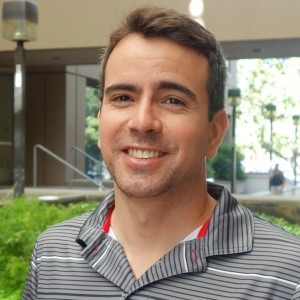
Gordon G. Krauss
- Courses2
- Reviews2
- School: University of Michigan
- Campus:
- Department: Mechanical Engineering
- Email address: Join to see
- Phone: Join to see
-
Location:
500 S State St
Ann Arbor, MI - 48109 - Dates at University of Michigan: April 2013 - January 2014
- Office Hours: Join to see
Biography
University of Michigan - Mechanical Engineering
Resume
1992
Ph.D.
Fibrous and Composite Materials Laboratory
Boston University
1992 – 1998\nGraduate Research Assistant\nDissertation: Inspection of Bonded Composites Using Selectively Excited Ultrasonic Modes\n·\tDeveloped improved nondestructive evaluation method for bond region of adhesively bonded composite plates.\n·\tNondestructive Testing: Investigated composite materials using a high precision
high resolution
3-axis motorized ultrasonic Nondestructive Evaluation scanning system.\n·\tEquipment Design: Designed and developed specialized angled incidence ultrasonic testing apparatus incorporating pulser/receiver
function generator
amplifier
oscilloscope
A/D boards
and angle sensor components.\n·\tComputer Modeling: Developed a Mathematica computational routine incorporating analytical conclusions to evaluate the influence of incident angle and frequency on waves propagating in anisotropic plates. \n·\tTeam Management: Supervision and mentoring of undergraduate and graduate engineering students.
Mechanical Engineering
Graduate Teaching Fellow 1991-1992
1997-1998\nInstrumentation & Theory of Experimentation
Fluid Mechanics
Energy Conversion
Propulsion\n\nHonors:\t\t\t\t\t\nJohn H. and Helen Cary Fitzgerald Award
1993 – 1994\nFor excellence in aerospace or mechanical engineering research.\n\"Ultrasonic Nondestructive Evaluation and Characterization of Polymer Composites\"\n\nGraduate Research and Teaching in Engineering Fellow
1992-1994. Department of Education Fellowship for Graduate Study.
1990
German
English
BS
Physics and Astronomy (double major)
Research Assistant
Summer 1989\n·\tCollected
reduced
and analyzed astronomical data at the Very Large Array
Socorro
NM.\n·\tReconstructed 3 cm wavelength radio telescope.\n\nAll-American Scholar
MS
Boston University
Claflin Hall
1993 – 1998\nSenior Resident Assistant\n·\tSupervised and trained fifty resident assistants for a five building
2000 resident campus. \n·\tAdjudicated violations of the Code of Student Responsibilities. \n·\tOn call emergency response for medical
fire
and other crisis events.\n·\tRecognized for Contributions
Achievement
and Leadership.\n\t\n\tBoston University
College of Engineering
Boston
MA
1991 – 1992
1997 – 1998\n\tGraduate Teaching Fellow\n\t\tInstrumentation and Theory of Experimentation\t\t\tFluid Mechanics \n\t\tEnergy Conversion\t\t\t\t\t\t\t\tPropulsion\n·\t Set up and supervised 4+ hour laboratory sessions. Monitored laboratory notebooks. \n \n·\t Mentored laboratory skills.\n·\t Developed and graded course projects. \n·\tLed discussion sections. \n\nResident Assistant for Engineering Floor
Boston University's Claflin Hall
1992 – 1993
Aerospace Engineering
Selected Graduate Course Work/Computer Language Skills/Short Courses:\nEngineering Acoustics\t\t\tMechanics and Design of Advanced Composite Materials \nMechanics of Materials\t\tAdvanced Materials Engineering \nApplied Elasticity\t\t\tNumerical Analysis \nProduction System Design \t\tProduction System Analysis
In situ observations of graphitic staples in crumpled graphene
T1 - In situ observations of graphitic staples in crumpled graphene N2 - Graphene is an exceptionally effective lubricant additive that performs well when crumpled rather than as flat sheets. In the literature
it has been suggested that crumpled...
Modes of feedback in design review process: Implications for utility and effectiveness based on student gender and tone
2017 Pacific Southwest Section Meeting: Tempe
Arizona Apr 20 Paper ID #20701 Modes of feedback in design review process: Implications fo...
Design Thinking in Design Education
Surface feature variations observed in 52100 steel sliding against a thin boron carbide coating
Boron carbide (B4C) is well known for its high hardness and wear resistance and has been used as a wear-resistant coating. If one of a pair of contact…
Surface feature variations observed in 52100 steel sliding against a thin boron carbide coating
Engineering
AFM
Tribology
Product Development
Lubrication
Analysis
Coatings
R&D
Science
Design
Materials
Teaching
Design of Experiments
Research
Surface
Krauss
Gordon
Krauss
Harvey Mudd College
Schick-Wilkinson Sword
The University of Michigan
University of Michigan
Ford Research Labs through TAC Automotive
Too often individuals and organizations are hampered by artificial limits on their design process resulting in sub-optimal design and new products. Through a structured creative process addressing internal and systematic bias
paradigm-breaking innovations focused on true user needs can be fully addressed and realized.\n\nMy engineering design feedback research focuses on two main points: \n1. Why didn’t anybody tell me and \n2. Why didn’t I listen when they told me?\nTo improve
we need to know what requires improvement. Too often our users
clients
and peers withhold critical feedback
perhaps in a misguided effort to be kind
when their authentic critique will let us improve our work and our design process. My research indicates that very simple changes in how we request feedback during design reviews improves the quantity received by an order of magnitude and substantially increases the quality of feedback. This method is also perceived as more open and candid
particularly by women in engineering. This work continues and may be broadly applicable to feedback and review in other contexts. \n\nI teach engineering with a focus on engineering design as a process
human centered design
bias and creativity in the design process
new product development
sustainability
and the integration of the design process to include considerations for management and manufacturing. I encourage students to apply design thinking and to behave entrepreneurially. \n\nTribology:\nI am research graphene as an anti-wear lubricant additive. I work with a specially produced graphene that remains dispersed in lubricants for long periods and has shown promise in reducing boundary regime wear in pin on dis experiments. My research also includes the abrasiveness of thin
ultra-hard coatings and their uses in reducing low cycle fatigue in sliding contacts. \n
Harvey Mudd College
Technical Specialist
Tribology of thin
hard coatings: Researching the wear properties of CVD and sputtered coatings such as amorphous Diamond Like Carbon and Boron Carbide. \n·\tExamination of micrometer and nanometer scale changes in morphology of coating and counter-surfaces using laser profilometer
atomic force microscope
and scanning electron microscope. \n·\tEnhancement of test apparatus for friction force measurement. Development of software to automate data analysis. \n·\tInvestigations of the chemical changes of the substrate
counter-surface
and wear debris. \n\nLow-cycle fatigue in bearing steels: Conducting tabletop dynamometer experiments designed to generate either surface initiated or subsurface initiated low-cycle fatigue in various traction drive components.\n·\tModeling forces and stresses in a traction drive (CVT). \n·\tSupervised installation
configuration
and modifications of dynamometer system. \n·\tExamination of SEM and optical micrographs to categorize fatigue damage.
Ford Research Labs through TAC Automotive
The University of Michigan
Ann Arbor
Michigan
Director
Metalworking Fluids Initiative\n•\tAcademic-Industrial partnership coordinating additive makers
fluid formulators
tool makers
machine tool makers and end users \n•\tImproving performance and sustainability of metalworking fluids and delivery systems for traditional machining operations such as metal forming
milling
turning
and grinding \n•\tResearching metalworking fluids and delivery systems including tribology
environmental impact
efficiency
micro-machining and use of novel fluid delivery systems using supercritical carbon-dioxide for machining operations\n\nCourse Coordinator and Lead Instructor
Capstone Design Course\n•\tTeaching all phases of the product design process including acquiring customer needs
developing engineering specifications
functional decomposition
brainstorming
concept evaluation
design for manufacturing
design for environment
ethics
safety
FMEA
engineering analysis
communication
prototyping
and validation\n•\tCoordinating and conducting rigorous oral and written design reviews throughout the term for all sections of the course including analysis of engineering drawings (CAD
typically SolidWorks or Pro-Engineer)
Finite Element Analysis (FEA)
timelines/plans (Gantt Charts)
budgets
and literature reviews.\n•\tProject development: growing the number of industrially based real world projects meaningful impact to industrial sponsors
sponsor coordination with the course including negotiation and management of non-disclosure and arising intellectual property
identifying non-industrial partners with challenging mechanical engineering projects\n•\tManaging projects in the in the instrumentation
automotive
aerospace
defense
energy
bio-medical
and pharmaceutical fields\n•\tDirect management of five teams per semester and coordination with sponsoring agencies and team guidance for over 20 design projects per term\n•\tCoordinating five faculty in instruction of the design process form specification development through validation
Director
Metalworking Fluids Initiative
Course Coordinator and Lead Instructor
Senior Scientist\n. Inventor of Hydro lubricating strip\n·\tManaged major interdisciplinary component improvement initiative from conception through development phases.\n·\tSupervised technicians.\n·\tInitiation and coordination of research collaborations with external partners.\n\nLaboratory Research\n·\tDesign of Experiments (DOE): designed
conducted
and evaluate experiments to evaluate biomechanical interaction. \n·\tInvestigated the frictional properties of metallic
ceramic
and polymer (especially elastomeric) materials in sliding contact with skin including hard (diamond like) and soft (low friction) thin coatings.\n·\tSpecialized development of physical tests of precision mechanical components during simulated and clinical use. \n·\tLinear and rotary friction force and wear testing with statistical data analysis of sliding contact experiments.\n·\tMaterial surface characterization with confocal microscopy
scanning probe microscopy (AFM/SPM)
Scanning Electron Microscopy (SEM)
and Nano-indentation testing.
Schick-Wilkinson Sword
Visiting Scholar
University of Michigan
